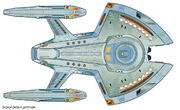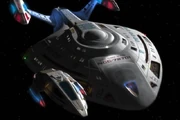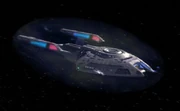The Nova-class was a type of Federation science vessel and scout starship in service in the 24th century, first entering service in 2368. The class was designed for short-range and limited duration research missions such as planetary or system surveys. Nova-class vessels were also tasked with doing the extensive and in-depth research and analysis on a chosen region after a larger explorer type ship had made the initial analysis. (ST reference: Starship Spotter)
History[]
Development[]

Early concepts for the Nova-class.
The name "Nova-class" was coined for a new Starfleet design in the 2360s. At the time of its inception, it was being modeled as the next evolution of the explorer design dynamic of the Galaxy-class. At least four designs were conceptualized for the new class; with a variety of innovative new arrangements, propulsion systems and modular designs proposed. One radical design featured a nacelles-forward central hull that would trail mission modules behind it. Another design maintained a more typical Starfleet arrangement, but distorted to make use of anticipated advances in warp technology to allow greater z-axis warp field compression. A third design also maintained a recognizable silhouette, but proposed variable geometry warp nacelles and a primary hull that was composed of interchangeable modules. The fourth design had entered service by 2370, as evidenced by the USS Aquitaine; like the Nova-class, of another design which had gone into production by 2368, this design featured an angular, almost triangular, primary hull, and was used as a small explorer and research vessel. (TNG reference: Star Trek: The Next Generation Technical Manual; TNG comics: "Children of Chaos", "Mother of Madness", "Brothers in Darkness")
- The class name of the USS Aquitaine was not revealed in any of the three comics it and its crew appeared in, though it presumably was named something other than Nova-class. The ship's crew complement is also never established, but appears to be somewhat smaller than the Nova-class, as the entire crew apparently participated in an away mission.

The original Defiant-class pathfinder design which formed the basis for the Nova-class
The final design of the Nova-class initially started out as a pathfinder for the proposed Defiant-class fast torpedo ship. However, with the looming threat of the Borg Collective, Starfleet Command radically altered the concept of the Defiant-class, rendering the pathfinder design unsuitable.
At this time, in the mid-2360s, Starfleet was looking for a successor for the long-lived Oberth-class which had been in constant operation for almost a century. After noting how well the Defiant pathfinder spaceframe had performed in early warp field simulations, the Advanced Starship Design Bureau selected the design as a suitable basis for the Oberth-class replacement. The original design underwent a series of modifications as it was re-purposed from being a warship to a science vessel, with the most notable change being the removal of the forward torpedo launchers and their replacement with powerful sensor arrays. (ST reference: Starship Spotter)
In service[]

By 2368 the prototype USS Nova had been built and commissioned. Unfortunately, the Nova-class program hit a misstep in 2370, when the newly launched USS Equinox vanished near the Badlands while performing a scientific survey. The loss of the Equinox, coupled with the fact that it was a new class, led to concern over its design. However, these fears were put to rest when a detailed analysis of the USS Nova and her sister ships revealed no discernible design flaws. Any lingering concerns were finally put to rest several years later, when the Equinox was discovered in the Delta Quadrant by the USS Voyager. (ST reference: Starship Spotter; VOY episode & novelization: Equinox)
Despite the concerns regarding the Equinox, other vessels of the class performed exceedingly well and Starfleet increased production, confident that they had found a suitable replacement for the Oberth-class. (ST reference: Starship Spotter)
Alternate timelines[]

The USS Rhode Island, variant of the Nova-class.
In one alternate timeline or possible future, a variant of the Nova-class was in service in the early 25th century. While the interior of the ship remained largely unchanged, the exterior had undergone a number of changes with notable alterations to the hull design; adding a new dome over the bridge and filling the gap at the front of the saucer section. The variant design also had superior firepower and shield strength over its predecessors. (VOY episode & novelization: Endgame)
In another alternate timeline, a Nova-class vessel (of the same variant design seen in the other alternate timeline) was still in Starfleet service during the 26th century, and was involved in the pivotal Battle of Procyon V. (ENT episode: "Azati Prime")
Specification[]
Appropriately for their mission profile, the Nova-class starships were essentially flying sensor platforms, with the most finely tuned and integrated large sensor arrays, which was unparalleled in its application on Starfleet vessels at the time. With the ships' main purpose being research and analysis, they weren't typically suitable for combat operations.
However, due to elements present in its original incarnation as a torpedo gunship, a Nova Class Starship was quite capable of defending herself; armed with 11 Type Xb phaser arrays and 2 forward torpedo tubes.[citation needed]
The class was also not designed with long term missions in mind; its compact design limited the amount of consumables able to be carried and also put restraints on the number of facilities more common on larger designs - the Nova-class did not have any holodeck facilities, nor did it carry the components to assemble a reserve warp core. With these considerations the typical maximum mission duration recommended for the class was two years. (Star Trek Fact Files; ST reference: Starship Spotter)
The Nova class was designed to operate at a maximum speed of warp eight, with maintainable cruising speed of warp 6, which was provided through an LF-47 Advanced Linear Warp Drive system. (ST reference: Starship Spotter)
The Nova-class was also one of a few Federation starship classes to be equipped with the ability to enter a planet's atmosphere and land on the surface, thanks to breakthroughs in gravity control and vessel structural integrity. Landing was achieved on four landing pads which extended from ports on the underside of the engineering hull. Although not a routine maneuver, this capability extended the uses of the ship, making it possible for a Nova-class vessel's crew to utilize the ship as a planetary research base. (ST reference: Starship Spotter; Star Trek Fact Files[citation needed]; Decipher RPG module: Starships)
Arrangement and layout[]

The Nova-class main systems display.
The design of the Nova-class was considered a compact form of its much larger contemporary, the Sovereign-class, and was also similar to the Intrepid-class, although the Nova was only half its size with a length of 222meters.[citation needed] The layout of the ship included a primary hull with a curved triangular shape, with the secondary hull directly attached to the primary hull and the ship's twin warp nacelles protruding to either side of the rear of the engineering section. (VOY episode: "Equinox", The Official Starships Collection Issue 15: "USS Equinox")
In keeping with traditional Starfleet design the bridge was located on deck one, although atypically it was surrounded by a built-up area of the hull, making the bridge slightly less vulnerable to attack (in a similar concept to the Akira-class and a hangover from the original warship design used as the basis for the class). The ships' impulse engines occupied the rear of deck two, while decks three and four featured a large cargo bay. The front of deck three housed the auxiliary deflector dish, and below it on deck four was a large array of sensor pallets, with additional sensors located on the underside of the saucer on deck four as well. To the rear of deck four was the ship's shuttlebay, as well as sickbay and the primary laboratory facilities. The remaining decks were largely occupied by engineering facilities, with the warp core extending through decks five to eight, and the primary deflector taking up most of the front of the engineering hull. (Star Trek Fact Files[citation needed])
Deflector systems[]

The shields of a Nova-class ship.
Like many other Starfleet vessels, Nova-class vessels were equipped with a navigational deflector at the bow of the secondary hull, which was designed to prevent space debris and objects colliding with the vessel and damaging her. If the main deflector was damaged or disabled, then a secondary deflector located on the primary hull could substitute. This secondary deflector dish also enhanced the vessel's long-range sensors.
The Nova-class was also equipped with a FSQ primary force field and deflector control system, located along the secondary hull, which provided shielding for defensive purposes. These shields could be fully recharged after charging the shield emitters for 45 seconds, however, this would require the shields to be dropped. (Star Trek Fact Files[citation needed]; ST reference: Starship Spotter; VOY episode & novelization: Equinox)
Tactical systems[]
Although the Nova-class wasn't designed for combat operations, they were still equipped with an assortment of weaponry which allowed them to safely defend themselves. They were equipped with eleven type-X phaser arrays: eight located on the saucer section and three on the secondary hull. The Novas were also armed with two forward-facing mk-95 photon torpedo tubes at the bow of the saucer opposite of the secondary deflector, and one aft-facing launcher. The ships were typically equipped with 15 science probes and 20 photon torpedoes, although they could also fire quantum torpedoes if so equipped. (ST reference: Starship Spotter; Decipher RPG module: Starships)
Auxiliary craft[]

The Waverider shuttle depicted in a Nova-class starship's master systems display.
Nova-class vessels typically had a complement of two shuttlecraft, stowed in their shuttlebays, and two work bees, typically held in their cargo bays. Additionally they were also equipped with a Waverider atmospheric operations shuttlecraft, which was mounted in a specially designed port on the underside of the primary hull similar to the captain's yachts on the Galaxy-class and Sovereign-class. The Waverider was able to reach one-half impulse and was Starfleet's most advanced atmospheric craft at the time. (ST reference: Starship Spotter; Star Trek Fact Files[citation needed])
Known vessels[]
- USS Aurora (NCC-72321) [6]
- USS Binary (NCC-72454)[6]
- USS Charribey (NCC-72399)[7]
- USS Equinox (NCC-72381)[8]
- USS Everett (NCC-72392)[9]
- USS Foundation [10]
- USS Freeman Dyson (NCC-72411) [6] [11]
- USS Lionheart (NCC-73808) [12]
- USS McCoy (NCC-91270)[13]
- USS Norfolk [14]
- USS Nova (NCC-72230/73515) [6] [15]
- USS Pulsar (NCC-72358) [6]
- USS Quasar (NCC-72369) [6]
- USS Rhode Island (NCC-72701) [16]
- USS Solstice (NCC-72409/73526) [6]
- USS Anticipation [17]
Appendices[]
Connections[]
References[]
- ↑ PIC episode: "Assimilation".
- ↑ 2.0 2.1 2.2 2.3 2.4 2.5 2.6 2.7 2.8 2.9 ST reference: Starship Spotter.
- ↑ STO - Future Proof mission: "Ragnarok".
- ↑ 4.0 4.1 4.2 4.3 ST reference: Star Trek: The Magazine: Volume 2, Issue 3
- ↑ 5.0 5.1 STO - Reflections mission: "Welcome to Earth Spacedock"
- ↑ 6.0 6.1 6.2 6.3 6.4 6.5 6.6 Decipher RPG module: Starships
- ↑ ST video game: Legacy
- ↑ VOY episode & novelization: Equinox
- ↑ DTI novels: Watching the Clock, Forgotten History
- ↑ TNG - The Sky's the Limit short story: "Trust Yourself When All Men Doubt You"
- ↑ Decipher RPG module: Worlds
- ↑ ST - The Fall novel: The Poisoned Chalice
- ↑ STO video game: Star Trek Online
- ↑ ST - Seven Deadly Sins novella: Revenant
- ↑ TNG movie: Star Trek Nemesis
- ↑ VOY episode & novelization: Endgame
- ↑ VOY - Strange New Worlds 6 short story: "Hidden"
Background[]
Apocrypha[]
The various ebooks published by Last Unicorn Games after they had lost their Star Trek license listed several other Nova-class starships: the USS K'Shal (NCC-73105), USS Nadir (NCC-74803) and the USS VanDenBroeck (NCC-69178). Alternative registry numbers were also given for several vessels later included in Decipher's Starships sourcebook.
The software for the game Star Trek: Legacy lists the USS Farrier, USS Hollis and USS Mullen as members of the class. However, these additional names are blocked from use by the software, so do not appear at any point during gameplay.
External link[]
- Nova class article at Memory Alpha, the wiki for canon Star Trek.
| This is a Featured Article |
|---|
| We believe it to be one of the best examples of the Memory Beta community's work. Even so, if you see a way this page can be improved even further, we invite you to contribute. Please go to the Nominations for Featured Articles page to discuss any other pages you feel deserve recognition. |
